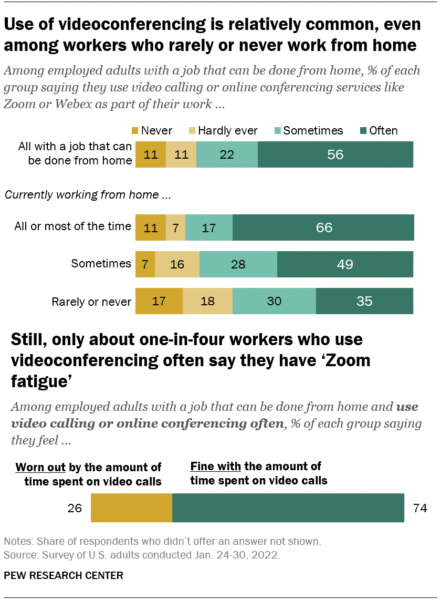As telework continues for many U.S. workers, no sign of widespread ‘Zoom fatigue’
May 6, 2022

A substitute teacher works from her home in April 2020 during the COVID-19 pandemic.A substitute teacher works from her home in April 2020 during the COVID-19 pandemic.
As remote work continues for many Americans, more than half of workers who say their jobs can mainly be done from home say they often use online platforms to connect with co-workers (56%). Most of these workers say they are fine with the amount of time they spend on video calls, but about one-in-four say they are worn out by it, according to a January 2022 Pew Research Center survey.

The use of video calling or online conferencing services, like Zoom or Webex, is particularly common among those whose jobs can be done from home and who are, in fact, working from home all or most of the time. About two-thirds of these workers (66%) say they often use online conferencing services, compared with 49% of those who work from home sometimes and 35% who rarely or never do so. Workers who are new to teleworking during the pandemic are more likely than those who had already been teleworking before the COVID-19 outbreak to use videoconferencing: 77% of those who currently work from home all or most of the time – but rarely or never teleworked previously – say they use these services, compared with 48% who currently telework and did so before the pandemic.
Among those who have a job that can be done from home, men are more likely than women to say they use online conferencing software often (61% vs. 51%). There are also age differences: 59% of workers ages 18 to 49 who have jobs that can be done from home say they use these tools often, compared with 48% of similar workers 50 and older. College graduates with jobs that can be done from home (68%) are also much more likely than those without a four-year college degree (40%) to say they use online conferencing software often. These differences hold up when looking only at those who are working from home all or most of the time.
Among those who regularly use videoconferencing tools for work, most are not bothered by the amount of time spent on video calls. Roughly three-quarters of working adults who use online conferencing services often (74%) say they are fine with the amount of time they spend on video calls, while 26% say they are worn out by it.
A Pew Research Center survey conducted in October 2020 – when 71% of those whose jobs can be done from home were teleworking all or most of the time – found that 37% of regular teleworkers who often used online conferencing said they were worn out by the amount of time spent on video calls, while 63% said they were fine with it.
In the more recent survey, there are demographic divides in the impact of frequently using these tools. Workers under 50 whose job can be done from home and who use videoconferencing platforms often are more likely than their counterparts ages 50 and older to feel worn out by the amount of time they spend on video calls (29% vs. 18%). Feeling worn out is also more prevalent among those with a bachelor’s degree or more education (31%) than among those with less education (15%).
About Author
Ruth Igielnik is a senior researcher at Pew Research Center.





























